The Ultimate Buyer’s Guide To Choosing A Scuba Diving Wetsuit
If you’re a diving enthusiast, you know the importance of choosing the right diving wetsuit. But, with so many options available in the market, it can be overwhelming to pick the right one for you. That’s why I have created the ultimate buyer’s guide to diving wetsuits, to help you make an informed decision.
This guide covers everything you need to know, from determining what thickness and size is right for you to the accessories you might need for your wetsuit. You’ll also learn about important wetsuit features and the various materials and linings that diving wetsuits can be made from, including the modern fleece material diving wetsuits.
Finally, I will share some helpful tips on how to take care of your diving wetsuit and increase its lifespan. Read on to know all about diving wetsuits!
How does a diving wetsuit work?
A diving wetsuit’s function is to keep you warm in the water and they are made out of a synthetic rubber called neoprene. A wetsuit keeps you warm by trapping a thin layer of water between your skin and the neoprene. This thin layer of water is heated up by your body and therefore keeps you warm. It’s important to get a wetsuit that has a close and comfortable fit, otherwise, cold water will constantly flush the warm water out.
Your wetsuit is not meant to keep you entirely dry. In fact, it works by trapping a thin layer of water between your skin and the suit. The water is then warmed up by your body heat. The material used in making wetsuits contains many tiny air bubbles and provides insulation against the colder water outside the suit. The thicker the neoprene, the warmer you will be.
It is also essential that the wetsuit fits properly – not loose or baggy. Otherwise, cold water will constantly flush the warm water out. While a quality wetsuit is quite an investment, it will greatly enhance the quality of your dive and even keep you safe from hypothermia and other conditions related to cold water exposure.
In addition to keeping you warm, a wetsuit provides a protective layer against jellyfish stings, scrapes, and other abrasions.
What is the difference between a full & shortie diving wetsuit?
One of the most significant factors to consider when choosing a wetsuit is the amount of coverage it provides. The two most common types of wetsuits are full-length suits and shortie wetsuits.
- A full wetsuit covers the entire body except for the head, hands, and feet.
- A shortie wetsuit only covers the torso, upper arms, and thighs. Shortie wetsuits are great for warmer water, as they offer greater flexibility and comfort.
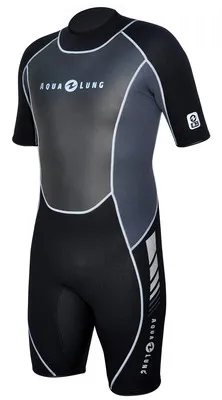
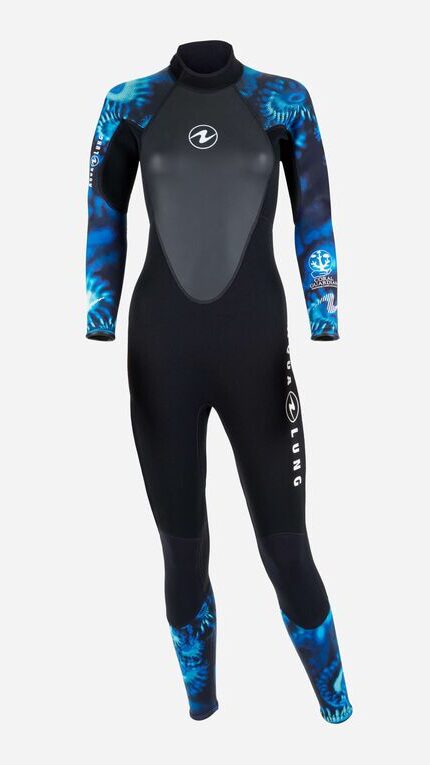
What thickness diving wetsuit do I need?
When it comes to wetsuits, the thickness of the neoprene is a crucial factor in keeping you warm in colder waters. However, thicker neoprene means less stretchiness, so finding the right balance is important. Wetsuits are measured in millimeters. Common wetsuit thicknesses are 3mm, 5mm, and 7mm.
However, some wetsuits utilize different thicknesses in different panels. Those designs usually put thicker neoprene around the torso and thinner material on the arms and legs for increased mobility.
The ideal wetsuit thickness depends on where and when you plan to dive. Start by checking the average water temperature at your diving location. As a general rule, you’ll need less thermal protection in warmer waters.
- 70°F (26°C) and above: 3mm neoprene wet suit or bodysuit
- 69°F to 79°F (21°C to 26°C): 5mm neoprene wetsuit
- 61°F to 68°F (16°C to 20°C): 7mm wetsuit or semi-dry
- 60°F (15°C) and below: Semi-dry or drysuit
Keep in mind that everyone’s tolerance to cold water is different, so the best suit is the one that you feel most comfortable in.
What size diving wetsuit do I need?
Ensuring proper fit is crucial when selecting a diving wetsuit. It not only affects your mobility but also prevents heat loss, which can be critical when you’re in cold water. If the suit is too loose, water will flush through it, reducing its thermal effectiveness. On the other hand, a diving wetsuit that’s too tight can restrict your movement and breathing.
To find the right size, start by determining the type of diving wetsuit you want. Consider the factors that apply. Then, check the sizing charts provided by the manufacturer and take your measurements. Keep in mind that sizing differs between brands, and some will offer tall or short sizes.
When trying on a wetsuit, it should be snug in all areas but not uncomfortably tight. Look for baggy spots or large wrinkles in the arms and legs as these may indicate a poor fit. If you’re unable to find the right size in the off-the-rack selection, consider a custom-made wetsuit. Although they may have a considerably higher price tag, custom suits offer the best way to ensure a proper fit by supplying a complete set of your specific measurements.
What materials are diving wetsuits made from?
Diving wetsuits are made from a variety of materials, but the most common and popular material is neoprene. Neoprene is an elastic synthetic rubber that has excellent insulation properties due to millions of microscopic bubbles trapped inside the material.
Neoprene was first used in wetsuits in the early 1970s and has since become more flexible, warmer, and more durable. However, neoprene is not the most eco-friendly material because it is based on oil. Additionally, some people are allergic to it or the substances used in its production.
To address these concerns, wetsuit manufacturers have started developing neoprene alternatives such as:
- Japanese Yamamoto neoprene
- Geoprene
- Naturalprene
- Bioprene
- Yulex
- Smoothskin
Japanese Yamamoto Neoprene
Yamamoto neoprene, made in Japan, is considered the highest quality of wetsuit neoprene available. It differs from regular neoprene because its cell structure is much denser, providing excellent thermal insulation while remaining strong, lightweight, and flexible. Yamamoto neoprene can stretch between 450% and 600%.
Geoprene
Geoprene wetsuit material is derived from the calcium carbonate found in limestone to create Polychloroprene Rubber. The material was also invented by Yamamoto Corporation in the 1960s. It is 98% water impermeable, keeping the wetsuit lighter, warmer, and drier. Additionally, Geoprene has a high stretch capacity that allows it to feel like a second skin.
Naturalprene
Naturalprene is a new type of diving wetsuit material developed by Taiwan-based manufacturer Sheico. It is made from hevea rubber, a plant-based material that is more environmentally friendly than traditional oil-based neoprene.
Bioprene
Bioprene is another eco-friendly diving wetsuit material made from calcium carbonate, which is sourced from discarded seashells. Wetsuits made from Bioprene are known for their flexibility, durability, and warmth, and they are a great choice for environmentally-conscious divers.
Yulex neoprene
Yulex neoprene is plant-based natural rubber material used for wetsuits. The material uses sustainably grown guayule plants, which require less water and land than traditional neoprene production. The latest range of Scubapro wetsuits use Yulex.
Smooth Skin Neoprene
Smooth skin neoprene is a type of neoprene that has a rubbery finish that repels water and wind while absorbing warmth from the sun and trapping extra body heat. Cold water wetsuits often feature smooth skin in the chest panel and lower back, which greatly increases the overall warmth of a wetsuit. However, smooth skin neoprene is less durable and is prone to tearing when getting in and out of a suit.
Fleece material diving wetsuits
Some wetsuits don’t use neoprene or rubber-type materials at all. Instead, they use dense fleece-like material with a nylon abrasion-resistant outer layer. Materials like Sharkskin’s Titanium Chillproof, Lavacore Lavaskin and Merino Laminate, and Fourth Element’s Thermocline are windproof on the surface and provide thermal protection equivalent to around 3mm of neoprene.
The benefit of these fleece material wetsuits is that they are exceptionally lightweight, machine washable, and dry incredibly quickly. They can also be worn underneath a neoprene diving wetsuit for additional insulation.
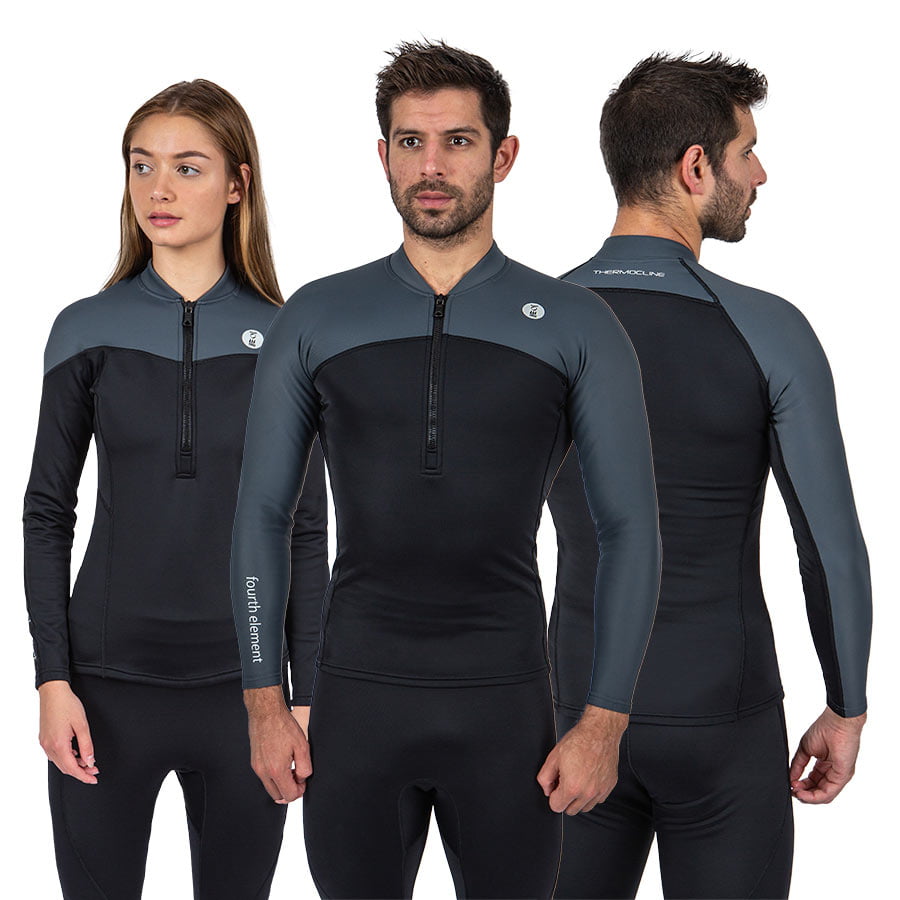
What are the features of a diving wetsuit?
Diving wetsuits have various features that should be considered when selecting the right wetsuit. Here are some of the key features:
Zip closure
The majority of wetsuits are zip wetsuits, either front-zip or back-zip. The chest-zip suits are less common and usually reserved for thicker wetsuits and semi-dry suits. The back-zip wetsuits are more common and come with a long pull cord that makes it easy for the diver to zip up themselves.
Additionally, some wetsuits feature small zips at the ankles and wrists. These can make donning and removing the wetsuit easier.
Neoprene panels
Wetsuits are made up of neoprene panels, which can have varying thicknesses across the body. The chest, abdomen, and back panels are typically thicker than the arms and legs, which allows for greater flexibility in areas that do not need full thermal protection.
Knee and elbow pads
Knee and elbow pads provide extra protection to high-wear areas and can be either integrated or laminated onto the neoprene. In addition, wrist seals help to minimize water flushing and keep divers warmer.

Integral hoods
Some wetsuits come with a built-in hood for additional thermal protection. Insulating the head has a large effect in reducing the loss of body heat. Integral hoods offer a better seal than using a separate hood.
Thigh pockets
Thigh pockets are an optional feature on some diving wetsuits. They usually have a velcro closure and inner D-rings to securely attach equipment. Many divers use thigh pockets to hold equipment such as reels, spools, backup lights, slates, and backup masks so they are streamlined and do not risk entanglements.

Wrist, ankle, and neck seals
Wrist and ankle seals help to minimize water flushing and keep divers warmer. These seals are usually an extra piece of thin rubbery membrane on the end of the wetsuit sleeves and at the ankles. Some wetsuits also feature seals around the neck.
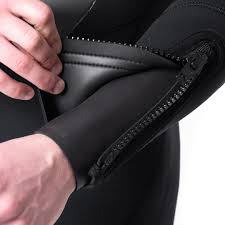
Chest pads
For spearfishing, a chest pad is a useful feature designed to protect the chest when loading a speargun with rubber bands and prevent the gun from slipping when charging it.
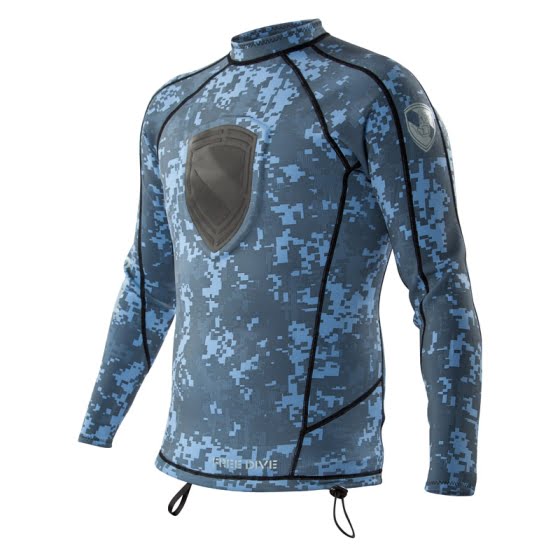
What are the differences in diving wetsuit seams?
When selecting a diving wetsuit, it’s important to consider the type of seams used in its construction. The seams are responsible for joining the neoprene panels together and play a critical role in the wetsuit’s durability, flexibility, and warmth.
In general, seams will either be sealed or unsealed. Sealed seams offer better thermal protection because they prevent water from entering or leaving the suit. In contrast, unsealed seams are typically used in cheaper wetsuits for tropical water diving.
Types of Stitching Used in Wetsuit Construction
- Overlock stitching: The simplest way of joining two pieces of neoprene. It is commonly used in cheaper wetsuits. There is no seal between wetsuit panels, so this type of stitching will allow water movement in and out of the wetsuit. This reduces the insulation it can provide.
- Flat-lock stitching: This method overlaps two pieces of neoprene and then stitches them together in a tighter zigzag pattern. Flat-lock stitching is suitable for warm water diving wetsuits and is more robust than overlock stitching
- Glued and stitched: This method is of higher quality and involves gluing neoprene segments together and then reinforcing them with stitching for ruggedness. Gluing the wetsuit panels improves thermal protection by preventing water from entering or leaving the wetsuit.
- Taped and stitched: The wetsuit panels are stitched together and then sealed with neoprene tape. In most cases, the wetsuit is fully taped. However, some wetsuits only use spot taping to reinforce critical areas.
- Welded Seam: This method uses a silicon-based urethane seal to join the neoprene panels, creating a water-tight barrier that makes a wetsuit 100% watertight. Because a needle doesn’t penetrate the neoprene, water can not leak through, which will keep you dry and warm. Welded seams typically offer more durability and flexibility compared to glued and stitched seams.
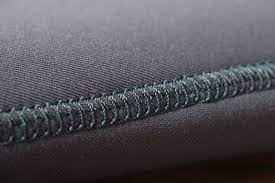
What linings can a diving wetsuit have?
When choosing a wetsuit, it’s essential to consider the type of lining it has. A lining is an extra insulating layer on the inside of a wetsuit that is usually found in mid-range to premium suits. The lining material used should be stretchy, lightweight, water-repellent, and quick-drying to keep you comfortable in the water.
The main benefit of a diving wetsuit lining is that it adds more warmth without having to wear a significantly thicker suit. That can be especially important for temperate and cold water conditions.
If you opt for a lining, note that the area covered by it on each wetsuit will vary. The more you’re willing to pay, the more coverage you’ll get. Some wetsuits won’t have a lining at all, such as entry-level or summer suits, whereas some wetsuits will be fully lined, others just the legs and torso, and some may have a single panel on the front to better protect your core.
Double-lined neoprene
Most wetsuits are made from double-lined neoprene, which means that the neoprene rubber is laminated to a certain lining material on both sides. Nylon and spandex are the most commonly used lining fabrics due to their durability, which helps protect the more fragile wetsuit material from damage. However, double-lined suits have reduced flexibility and increased heat loss above the water due to the effect called evaporative cooling.
Proprietary lining fabrics
To mitigate the problems of double-lined suits, many brands have developed their own proprietary fabrics for the internal lining. These fleece-like fabrics usually contain large amounts of trapped air, which is one of the best insulation materials. Examples include Fourth Element‘s Hexcore lining, Bare‘s OMNIRED, Scubapro‘s Blue Diamond Span, and Pinnacle‘s Merino linings.

Titanium diving wetsuit lining
The primary benefit of a titanium-lined wetsuit is that you can wear a thinner, more flexible suit without compromising warmth. To achieve this, a thin layer of titanium is applied to the neoprene surface before the outer fabric material is bonded to it.
The Titanium lining appears like a coat of silvery-grey paint on the neoprene surface. When diving, the thermal heat generated by your body is reflected back toward you. As a result, heat retention increases by up to 40%. Aqualung use titanium linings in some of their diving wetsuits.
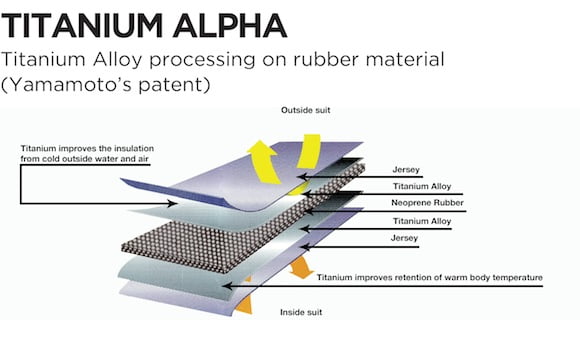
Unlined Smoothskin suits
Unlined suits, also known as smoothskin, superskin, or open-cell suits, usually have a smooth or grained surface on the outside and a porous cell neoprene surface on the inside. They are extremely soft, elastic, and comfortable, but they are best suited for expert competitive freedivers and triathletes. The downside of this type of wetsuit is that they are very delicate and fragile, especially prone to being torn by fingernails when getting in and out of a suit.
Can I use a surfing wetsuit for scuba diving?
Diving wetsuits are designed to work under pressure, and the neoprene used in them is denser than the neoprene used in surfing wetsuits. Surfing wetsuits rely on flexible neoprene panels to give a maximum range of movement, whereas diving wetsuits only need to accommodate leg movement.
The primary difference between a diving wetsuit and other types of wetsuits is the density of the neoprene material. When a diver descends, the water pressure increases, which compresses the existing gas bubbles in the neoprene.
This compression causes the wetsuit to become thinner and less insulating. However, the denser material used in diving wetsuits compresses much less as you descend, which allows the wetsuit to maintain its thickness and insulation.
In addition to the density of the neoprene material, diving wetsuits often have reinforced panels to protect against abrasion from dive equipment, such as weight belts, BCDs, and tanks. This added durability is crucial for protecting your wetsuit from wear and tear during dives.
While it’s technically possible to use a surfing wetsuit for scuba diving, it’s not recommended. Diving wetsuits are designed specifically for diving and provide better protection, warmth, and durability than surfing wetsuits.
What accessories might I need with my diving wetsuit?
Investing in the right wet suit accessories can make all the difference in keeping you warm and comfortable during your dives. Here are some accessories to consider for your wetsuit:
Neoprene diving hoods
Wetsuit hoods are a must-have accessory for cold water diving. They keep your head warm and protect you from the dreaded brain freeze. However, it can be annoying to have an integral hood hanging off the back of your suit when not in use.
For that reason, you can get a separate hood. A separate diving hood is an easy way to upgrade your wetsuit for cold water conditions. It also allows for flexibility in what you wear, depending on the water temperature.
When choosing a diving hood, make sure it is a close fit to prevent water from entering and making you colder. More expensive hoods come with face seals to reduce heat loss. Some hoods stop at the neck, whereas others a ‘bib-style’ – layering under your wetsuit down to your upper chest.
Neoprene diving booties
Neoprene diving booties are essential for temperate and cold water diving. They are also popular with warm water divers who want to use open-heeled diving fins.
Neoprene diving booties are sold with hard or soft soles. Hard soles are a favorite choice for divers who need protection from foot injuries or comfort on rough ground when entering the water.
Like all wetsuit items, boots should be as tight-fitting as comfortably possible to prevent water movement. The thickness needed will be determined by water temperatures.
Neoprene diving gloves
Numb fingers are a common issue for cold water divers. Neoprene diving gloves can help keep your hands much warmer. Like hoods, gloves should be close-fitting to prevent too much cold water from entering and causing your hands to freeze.
When choosing glove thickness, the same advice for boots applies: go as thin as possible for optimum movement and feeling, without your hands getting cold.
Upgrade your diving gloves if your hands get cold quickly.
Wetsuit gloves come in various styles, including:
- Standard 5-finger gloves: offer the most dexterity, but the least thermal protection.
- 3-finger gloves: also called lobster gloves, give you free use of your thumb and index finger while keeping the other three fingers warm.
- Mittens: these are the warmest but significantly limit dexterity.
Pocket Over-Shorts
If your diving wetsuit lacks integral thigh pockets, you can invest in a pair of over-shorts with pockets. These shorts are worn over the top of your wetsuit and provide storage pockets on each thigh for your equipment.
How to take care of a diving wetsuit?
Congratulations on your new wetsuit! To help you get the best possible wear out of it, follow these guidelines:
Putting on your diving wetsuit
- Be gentle when putting on your wetsuit. Yanking it about will put undue stress on the neoprene and could even tear seams.
- Start at the bottom with your feet and slowly work your way up to the waist.
- To help get your feet through the leg openings, put a plastic bag on each foot and simply slide them through.
- Once the wetsuit is up to the waist, adjust it so that the bottom half fits correctly over your legs. Then roll the rest of the suit up the body and put your arms through.
- Make sure the suit fits correctly before doing the zipper up. Avoid forcing the zip as it will be costly to repair. Slowly and smoothly is always the best way.
Taking your diving wetsuit off
- Work in the reverse of putting on your wetsuit and take your time.
- Try not to pull too hard on the zip if it is sticky. Instead, ask you buddy to help.
- Peel your suit off and leave it inside out. This will cause less stress on seams and is better for drying out after use.
Drying and storing your diving wetsuit
- Before drying your wetsuit out fully, rinse it with cold, clean, fresh water (the sooner after use the better). This removes salts that perish the neoprene and corrode zips.
- Air dry your wet suit inside out and sheltered from direct sunlight.
- Do not hang a soaked wetsuit by the shoulders as the weight can strain the neoprene and seams at the shoulders.
- Avoid using metal hangers as these can rust and result in staining.
- The best way to hang a wetsuit is folded at the waist over a line.
- Once the inside is dry, turn the wetsuit the right way and let the outside dry.
- Never dry a neoprene wetsuit in a tumble dryer. This will destroy the materials
- Store your wetsuit in an area away from direct sunlight that is cool and dry.
- Make sure the suit is fully dry before placing it on a large wide non-metal hanger to support the shoulders properly.
- Secure velcro fastenings to avoid abrasion on the neoprene.
Things That Can Damage Your Diving Wetsuit
- Do not fold your wetsuit up and store it when wet. This will result in mold growing on your suit.
- Do not use harsh chemical cleaners on your wetsuit.
- Do not use hot water to rinse out your wetsuit as this can dissolve the glue in the seals.
- Do not wash neoprene wetsuits in a washing machine.
Are you ready to buy your scuba diving wetsuit?
As a diving enthusiast, choosing the right diving wetsuit is crucial for your comfort and safety. With the plethora of options available in the market, it can be overwhelming to make the right choice.
In this guide, you learned everything you need to know to make an informed decision, from choosing the right thickness and size to understanding the various features, seams, and materials of diving wetsuits. You also learned about fleece material diving wetsuits and the accessories you might need to enhance your diving experience.
Now that you have made your purchase, I shared some useful tips on how to take care of your diving wetsuit and extend its lifespan. By following these tips, you can ensure that your diving wetsuit stays in top condition and serves you well for many dives to come.
I hope this ultimate buyer’s guide to diving wetsuits has been helpful and informative for you. Happy diving!
About The Author

Andy Davis is a RAID, PADI TecRec, ANDI, BSAC, and SSI-qualified independent technical diving instructor who specializes in teaching sidemount, trimix, and advanced wreck diving courses.
Currently residing in Subic Bay, Philippines; he has amassed more than 10,000 open-circuit and CCR dives over three decades of challenging diving across the globe.
Andy has published numerous diving magazine articles and designed advanced certification courses for several dive training agencies, He regularly tests and reviews new dive gear for scuba equipment manufacturers. Andy is currently writing a series of advanced diving books and creating a range of tech diving clothing and accessories.
Prior to becoming a professional technical diving educator in 2006, Andy was a commissioned officer in the Royal Air Force and has served in Iraq, Afghanistan, Belize, and Cyprus.
In 2023, Andy was named in the “Who’s Who of Sidemount” list by GUE InDepth Magazine.
Purchase my exclusive diving ebooks!
Originally posted 2023-04-20 17:08:43.















